
Lauren Oudin has many roles. She is On-Island director of Research and Education at USC Wrigley Institute for Environmental Studies, director of Blue Caverns Onshore State Marine Conservation Area, chair of the Catalina MPA Collaborative and, as of January, a Catalina Island Conservancy Last Friday Lecture Series featured speaker.
The Conservancy has asked Oudin to speak about Catalina’s nine Marine Protected Areas for the free monthly series.
“How many of you like the ocean?” she asked the packed room at the Trailhead visitor center. “Oh good,” she said as hands flew up. “I was hoping no one would boo, otherwise you’re in the wrong talk.”
Oudin explained that MPAs are necessary both to allow sensitive ocean ecosystems to recover and to prevent future damage.
“When you’re sick, you know that you need to drink your fluids and get more rest. You need to stop overworking yourself,” she said. “MPAs are like that. If you set aside some areas and let them rest, they can start to heal.”
MPAs are areas of coastal ocean that have been set aside to protect ocean life and habitat, where natural and cultural resources are given greater protection than the surrounding waters. No specific species or habitat is singled out; instead, tackling issues from an ecosystem approach. These areas protected from the beaches through deep water and are just one tool used to address issues happening within our ocean, working in concert with Marine zoning, water quality, the Endangered Species Act, fisheries regulations and coastal planning. California is the first state in the nation to develop a full network of Marine Protected Areas.
Ocean-lovers can still enjoy many of their favorite activities in MPAs.
“You can do lots of things – lots of things that don’t involve taking. You can go, enjoy and recreate, but not remove fish or invertebrates,” said Oudin. Each MPA is given a designation denoting what type it is and the specific regulations in place.
Catalina has nine MPAs. Long Point State Marine Reserve is a State Marine Reserve, which provides the most protection as a no-take zone. Blue Cavern Onshore and Casino Point are both No-Take State Marine Conservation Areas, prohibiting the taking of living, geological and cultural marine resources, but allowing for specific permitted activities. For instance, feeding of the fish at Casino Point is allowed. The final six Catalina MPAs, Lover’s Cover, Farnsworth Onshore, Farnsworth Offshore, Cat Harbor, Arrow Point to Lion Head Point, and Blue Cavern Offshore, are all State Marine Conservation Areas, allowing or limiting selected recreational and/or commercial taking. Before venturing into an MPA, be sure to research regulations for that specific MPA.
Creating these MPAs was a very involved process. Southern California is very complex, with nearly 18 million people and more than 50 incorporated cities with a very heavily used coastline. Oudin recalled public meetings and comment sessions that lasted until 1:30 a.m. MPAs were officially designated in the Marine Life Protection Act. The hard work paid off – MPAs work.
“Based on a global review of 124 marine reserves, what we find is you get bigger fish. Their body size increases by 28 percent,” said Oudin. She added that there are also more fish. “Density increases by 166 percent – that’s a big change.” There’s also more variety, with species diversity increasing by 21 percent.
MPAs have also been shown to be more resistant to invasive species, a fact at which every conservationist in the room perked up. “Areas that have been protected and have these intact ecosystems are going to have a better chance at riding out invasive species or other stressors,” she said.
Basically, MPAs preserve special places.
“They protect the entire ecosystem including the plants, animals and habitats, not just a single species. This helps boost fish abundance, diversity and economic prosperity,” said Oudin. “This means more fish and healthier ecosystems to be enjoyed by generations to come.”
Those who are interested in becoming more involved can join the Catalina Island MPA Collaborative at mpacollaborative.org or by attending the next meeting on March 11.
This month’s Last Friday Lecture Series will take place at the Nature Center at the top of Avalon Canyon, Feb. 28 at 5:30 p.m. This always-free event presented by Catalina Island Conservancy will feature Chris Clark, PhD, from University of California Riverside, who will discuss hummingbirds in the Channel Islands. There will be a bird walk in the wildlands the morning after this lecture. Dr. Clark will be available to answer questions during this approximately 2-mile excursion. Tickets are available for $45 and seats are limited! Please call the Nature Center to register at 310-510-0954 x226 or visit http://bit.ly/BirdWalk2020.










